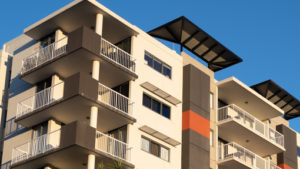Walls and Glazing (J1.5)
In the past, a building’s external walls, internal envelope walls, and glazing, were assessed as three separate components. With NCC 2019, the conditioned envelope wall-glazing construction is assessed as a whole, either for the whole building or per facade.
There are four steps to achieving compliance, but first we need to understand the measurement language.
Previously, walls were only measured by R-Value, which is the measure of an element’s resistance to heat flow. A building material’s R-Value depends on the material thermal conductivity and the thickness of the material. The total R-Value of a wall is calculated by adding up all the R-Values of the individual components that make up the wall (e.g. cladding, airspaces, insulation, lining, etc.)
Glazing, like any material, also has an R-Value, but because the number is so small, traditionally it has been communicated as a U-Value, which is 1/R-Value.
e.g. Glazing A: R-Value 0.13 => U-Value 7.9
e.g. Glazing B: R-Value 0.22 => U-Value 4.5
With the NCC 2019, the wall-glazing requirement is expressed in U-Values. U-Values are still a measure of a construction material’s resistance to heat flow, but the difference of U-Value to R-Value is that it’s an inverse measurement, so a lower value is more resistant to heat flow (and corresponds to a higher R-Value).
As mentioned earlier, there are four main requirements for wall-glazing construction compliance. These need to be met simultaneously, and have led to the creation of some fantastic excel spreadsheet formulas.
Note: Up to point of writing, the NCC has not yet released a working calculator to show compliance with the wall-glazing provisions. Their beta release has some errors which will be fixed, but we did not want to wait for their release, so we have created our own. Ours is better and we actually understand all the calculations behind the results, and so will be able to model different scenarios (e.g. changing glazing from clear to tinted in a specific facade) with more ease.
What are the Wall-glazing requirements?
(a) The total system U-Value of the wall-glazing construction must not be greater than U 2.0 (in Climate Zone 2).
This equates to an R-Value of R 0.5, which is far less than the R 3.3 we previously needed to achieve.
However, remember that now the total system U-Value is calculated as the area-weighted average of the total system U-Value of each of the components, including the glazing. And as we saw previously, even Low-E glazing has U-Value of 4.5. So the wall insulation has to compensate for the glazing’s higher U-Value, as high numbers are not good when it comes to U-Values and insulation.
NCC 2019 also requires the incorporation of thermal bridging into the total wall-glazing calculation. Thermal bridging occurs where the cladding is attached to the frame. The U-Value of the wall construction will be different at the point of frame compared to where there is insulation, and this proportion of thermal bridging also needs to be calculated and taken into account. The U-Value will be lower for timber frames than steel frames.
The wall construction requirement of achieving a max U-Value of U 2.0 can be achieved either:
1. By assessing each aspect (North, South, East, and West) of a building separately OR
2. By including all aspects together, allowing for trading off of better and worse performing facades
Note that Spandrel Panels (but not display glazing, which we will come to shortly) have their own separate but contributing calculation method to the WGC calculations.
This is a fairly complex calculation that incorporates the area-weighted components of glazing, wall and frame – each with their own U-Value – and comes up with a Total Wall-glazing Construction U value for the combined conditioned envelope walls facing a particular aspect.
(b) The Wall Component of a wall-glazing construction (WGC) must achieve a minimum R-Value of either:
1. R1.0 (where the wall is less than 80% of the WGC) OR
2. R1.4 (where the wall is more than 80% of the WGC) in Climate Zone 2
Note: this calculation must incorporate thermal bridging, so it’s not as ‘easy’ as it sounds.
(c) The Solar Admittance of external wall-glazing constructions must not exceed 0.13 in Climate Zone 2 for most classes of buildings.
As with the wall-glazing construction calculations as a whole, there are two methods for calculating Solar Admittance compliance:
1. By assessing each aspect (North, South, East and West) of a building separately (the glazing component is area weighted with the wall component); OR
2. By including all aspects together, and verifying that the total Solar Admittance load for the whole building is less than that of a reference building that is modelled using the maximum Solar Admittance allowed.
The Solar Admittance calculations take shading into account, and note that to include shading, there is still the requirement for the shading projection to extend horizontally on both sides of the glazing for at least the same distance as the projection.
(d) Display Glazing Requirements. Display glazing and non-glazed openings (such as doors) are excluded from the three wall-glazing calculations above. This means that buildings with a lot of display glazing that were previously not good candidates for a DTS Assessment may now be suitable in some instances. Display glazing is now defined as glazing used to display retail goods in a shop or showroom directly adjacent to a walkway. It is still required to have a Total System U-Value not exceeding 5.8 (i.e. Low-E or DG), and a Total System SHGC that is dependent on the glazing element’s shading and aspect. This is calculated separately.
Confused yet? BERA is across all the detail and ready to assist our clients in understanding and achieving compliance with NCC 2019 Section J Requirements.
You may be pleased to know that the changes to the remaining elements in a Section J Assessment are not as significant as the Wall-glazing calculations.

